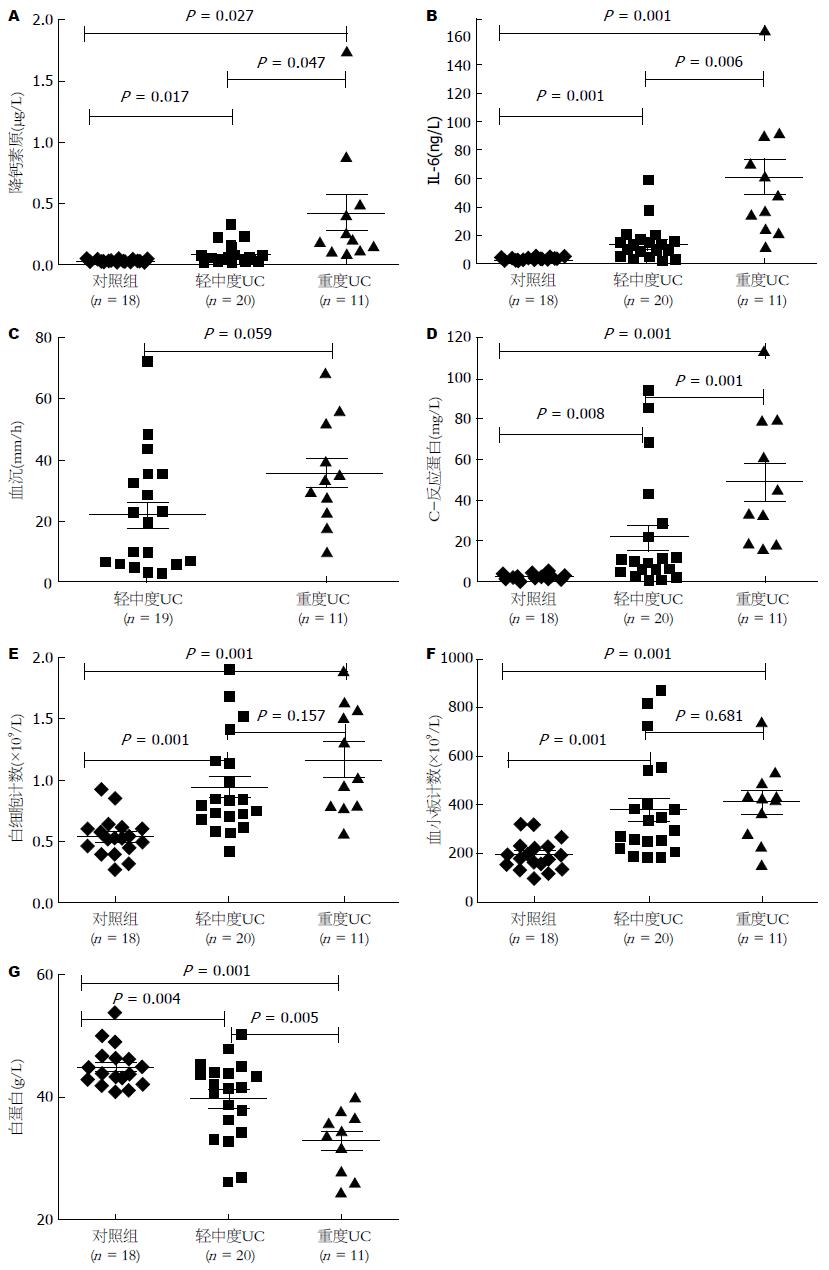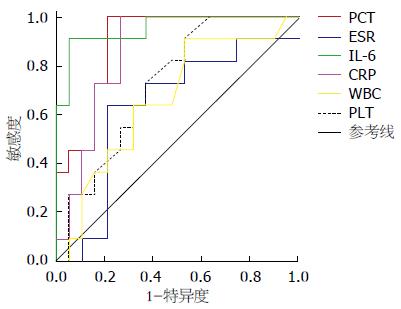修回日期: 2014-11-24
接受日期: 2014-11-27
在线出版日期: 2015-01-08
目的: 研究溃疡性结肠炎(ulcerative colitis, UC)患者降钙素原(procalcitonin, PCT)水平的变化与病情活动和炎症相关指标的关系.
方法: 检测31例UC患者与18例健康对照者外周血PCT水平, 与检测的炎症相关指标[白细胞计数(white blood count, WBC)、血小板计数(blood platelet count, PLT)、血沉(erythrocyte sedimentation rate, ESR)、白蛋白、C-反应蛋白(C reactive protein, CRP)和白介素-6(interleukin-6, IL-6)]进行相关性分析. Truelove-Witts评分标准区分轻、中、重度UC. 受试者工作特征(receiver operating characteristic, ROC)曲线分析诊断的准确性.
结果: 重度UC患者的PCT水平(n = 11, 0.426 μg/L±0.506 μg/L)明显高于轻中度UC(n = 20, 0.079 μg/L±0.085 μg/L)和健康对照组(n = 18, 0.03 μg/L±0.01 μg/L)(相应的P值为0.047和0.027). UC患者PCT水平与CRP、IL-6水平、ESR呈明显正相关, 与白蛋白水平呈明显负相关(P<0.05); 与WBC和PLT的相关性无统计学意义(P>0.05). 血清PCT水平预测重度UC优于ESR、CRP水平和WBC, 相应的ROC曲线下面积(95%可信区间)分别为0.895(0.782-1.000)、0.727(0.548-0.906)、0.856(0.721-0.992)和0.665(0.463-0.867), 相应的P值为<0.001、0.041、0.001和0.138. PCT>0.1 μg/L对预测重度UC具有较高的准确性, 他的敏感性、特异性、阳性预测值及阴性预测值分别为90.91%、80.00%、71.43%和94.12%.
结论: PCT水平是一个判断UC病情活动和反映UC病情严重程度的较好指标, 与炎症标志物CRP和ESR具有良好的相关性, PCT>0.1 μg/L作为阈值能够预测大部分重度UC.
核心提示: 降钙素原(procalcitonin, PCT)水平是一个判断溃疡性结肠炎(ulcerative colitis, UC)病情活动和反映UC病情严重程度的较好指标, 与炎症标志物C-反应蛋白(C reactive protein)和血沉(erythrocyte sedimentation rate)具有良好的相关性, PCT>0.1 μg/L作为阈值能够预测大部分重度UC.
引文著录: 袁柏思, 金鑫鑫, 路又可, 刘炯, 王少东, 王震凯, 吴琳, 汪芳裕. 溃疡性结肠炎患者血清降钙素原检测的临床价值. 世界华人消化杂志 2015; 23(1): 37-43
Revised: November 24, 2014
Accepted: November 27, 2014
Published online: January 8, 2015
AIM: To investigate the association of serum procalcitonin (PCT) level with disease activity and inflammatory markers in ulcerative colitis (UC).
METHODS: Serum PCT levels, white blood cell count, platelet count, erythrocyte sedimentation rate (ESR), albumin, C-reactive protein (CRP) and interleukin-6 (IL-6) levels were analyzed in 31 patients with UC and 18 healthy volunteers. Severity assessments were based on the Truelove and Witts' severity index. Spearman's rank correlation and receiver operating characteristic (ROC) analysis were used to evaluate correlations between variables and diagnostic accuracy, respectively.
RESULTS: Serum PCT level in severe UC patients (n = 11, 0.426 μg/mL ± 0.506 μg/mL) was significantly higher than those in mild-to-moderate UC patients (n = 20, 0.079 μg/mL ± 0.085 μg/mL) and healthy volunteers (n = 18, 0.03 μg/mL ± 0.01 μg/mL) (P = 0.047, 0.027, respectively). Serum PCT level in UC patients was positively correlated with CRP levels, IL-6 levels and ESR, negatively with albumin levels (P < 0.05), but showed no statistically significant correlation with white blood cell count or platelet count (P > 0.05). PCT performed well in the prediction of UC, and was superior to CRP, ESR and white blood cell count for diagnosing severe UC. The area under the ROC curve was 0.895 (95%CI: 0.782-1.000, P < 0.001), 0.727 (95%CI: 0.548-0.906, P = 0.041), 0.856 (95%CI: 0.721-0.992, P = 0.001) and 0.665 (95%CI: 0.463-0.867, P = 0.138), respectively. A threshold of 0.1 μg/L for PCT may detect the most severe form of UC, and the sensitivity, specificity, predictive positive value and negative predictive value predictive were 90.91%, 80.00%, 71.43% and 94.12%, respectively.
CONCLUSION: Serum PCT level correlates with disease activity markers ESR and CRP in UC, and a cut-off of 0.1 μg/L could distinguish the most severe form of UC.
- Citation: Yuan BS, Jin XX, Lu YK, Liu J, Wang SD, Wang ZK, Wu L, Wang FY. Clinical significance of serum procalcitonin in patients with ulcerative colitis. Shijie Huaren Xiaohua Zazhi 2015; 23(1): 37-43
- URL: https://www.wjgnet.com/1009-3079/full/v23/i1/37.htm
- DOI: https://dx.doi.org/10.11569/wcjd.v23.i1.37
溃疡性结肠炎(ulcerative colitis, UC)是一种病因不明的慢性非特异性肠道炎症性疾病. 降钙素原(procalcitonin, PCT)是降钙素的前体, 是一种无激素活性的糖蛋白, 正常情况下主要由甲状腺C细胞和肺的神经内分泌细胞产生[1]. 作为一种炎症标志物, 在败血症或其他细菌感染性疾病病情严重程度和预后中得到广泛的应用[2-12]. 同时, PCT亦可作为判断一些慢性炎症及自身免疫性疾病病情活动的指标[13-18]. 但在肠道炎症性疾病的UC中的研究较少, 本研究拟探讨UC患者血清PCT水平与UC病情严重程度判断以及和炎症相关指标的关系.
研究人群为2014-01/2014-09中国人民解放军南京军区南京总医院住院的UC患者, 本研究临床数据摘自医院的电子病历、内镜诊断、影像学和实验室检测资料. UC诊断标准参照中华医学会消化病学分会炎症性肠病协作组2012年制订的《炎症性肠病诊断与治疗的共识意见(2012年•广州)》[19]. UC的蒙特利尔分型[20]为E1: 局限于直肠, 未达乙状结肠; E2: 累及左半结肠(脾曲以远); E3: 广泛病变累及脾曲以近乃至全结肠. 将符合标准的患者资料纳入本研究进行统计分析, 纳入研究的31例UC患者中, 根据Truelove-Witts评分标准[21]分为轻、中、重度UC. 对照组为健康人群共18例, 男8例, 女10例, 平均年龄为50.3岁±13.8岁, 既往无肝炎、结核、自身免疫性疾病等疾病史, 近3 mo无特殊服药史. 收集所有入选者入院时的外周血标本. 本研究得到中国人民解放军南京军区南京总医院伦理委员会批准, 入选者均知情同意.
标本采集和检测: 受检者均于早晨空腹采集静脉血4 mL, 电化学发光免疫分析法检测血清PCT(参考值<0.046 μg/L)和白介素-6 (interleukin-6, IL-6)水平(参考值<7 ng/L), 免疫比浊法检测C-反应蛋白(C reactive protein, CRP)水平(参考值<8 mg/L), 另通过血细胞分析仪检测白细胞计数(white blood count, WBC)(参考值4×109-10×109/L)、血小板计数(blood platelet count, PLT)(参考值100×109-300×109/L), 自动化生化分析仪检测血清白蛋白水平(参考值35-55 g/L), 魏氏法检测血沉(erythrocyte sedimentation rate, ESR)结果(参考值0-15 mm/h).
统计学处理 采用SPSS22.0软件包进行统计学处理. 两组均数的比较采用t检验, 相关性分析采用Spearman检验, P<0.05为差异有统计学意义.
纳入研究的31例UC患者相应的临床特征如表1.
本研究检测轻中度和重度UC患者的PCT水平与病情活动相关的几个炎症相关指标(WBC、PLT、ESR、CRP、白蛋白和IL-6), 并将结果与对照人群相比. 结果显示, UC患者PCT水平、WBC、PLT、CRP、ESR和IL-6水平均明显高于健康对照组, 白蛋白水平明显低于健康对照组(P<0.05); 重度UC患者的PCT水平、CRP和ESR明显高于轻中度UC, 白蛋白水平明显低于轻中度UC(P<0.05), WBC和PLT的差异无统计学意义(P>0.05); 健康对照人群与UC患者的各个指标比较以及相应的P值如图1.
我们对炎症标志物(PCT、CRP、ESR)在不同的水平预测重度UC的敏感性、特异性、阳性预测值及阴性预测值进行分析, 相应的结果以及95%可信区间如表2. 炎症标志物预测重度UC的ROC曲线如图2, PCT、ESR、CRP、IL-6、WBC和PLT的ROC曲线下面积(95%可信区间)分别为0.895(0.782-1.000)、0.727(0.548-0.906)、0.856(0.721-0.992)、0.952(0.876-1.000)、0.665(0.463-0.867)、0.636(0.421-0.852), 相应的P值为<0.001、0.041、0.001、<0.001、0.138和0.22.
| 炎症标志物 | 敏感性(95%CI) | 特异性(95%CI) | 阳性预测值(95%CI) | 阴性预测值(95%CI) |
| PCT(μg/L) | ||||
| ≥0.050 | 100.00(67.86-100.00) | 50.00(27.85-72.15) | 52.381(30.34-73.61) | 100.00(65.55-100.00) |
| ≥0.075 | 100.00(67.86-100.00) | 80.00(55.73-93.39) | 73.33(44.83-91.09) | 100.00(75.93-100.00) |
| ≥0.100 | 90.91(57.12-99.52) | 80.00(55.73-93.39) | 71.43(42.00-90.42) | 94.12(69.24-99.69) |
| ≥0.125 | 72.73(39.32-92.67) | 80.00(55.73-93.39) | 66.67(35.44-88.73) | 84.21(59.51-95.83) |
| ≥0.150 | 63.64(31.61-87.63) | 85.00(61.14-96.04) | 70.00(35.37-91.91) | 80.95(57.42-93.71) |
| ≥0.200 | 45.45(18.14-75.44) | 85.00(61.14-96.04) | 62.50(25.89-89.76) | 73.91(51.31-88.92) |
| ≥0.300 | 36.37(12.37-68.39) | 95.00(73.06-99.74) | 80.00(29.88-98.95) | 73.08(51.95-87.65) |
| ≥0.400 | 36.37(12.37-68.39) | 100.00(79.95-100.00) | 100.00(39.58-100.00) | 74.07(53.41-88.13) |
| CRP(mg/L) | ||||
| ≥8 | 100.00(67.86-100.00) | 45.00(23.83-67.95) | 50.00(28.80-71.20) | 100.00(62.88-100.00) |
| ≥15 | 100.00(67.86-100.00) | 70.00(45.67-87.16) | 64.71(38.62-84.74) | 100.00(73.24-100.00) |
| ≥20 | 72.73(39.32-92.67) | 70.00(45.67-87.16) | 57.14(29.65-81.19) | 82.35(55.80-95.33) |
| ≥30 | 72.73(39.32-92.67) | 80.00(55.73-93.39) | 66.67(35.44-88.73) | 84.21(59.51-95.83) |
| ≥40 | 54.55(24.56-81.86) | 80.00(55.73-93.39) | 60.00(27.37-86.31) | 76.19(52.45-90.88) |
| ≥60 | 36.36(12.37-68.39) | 85.00(61.14-96.04) | 57.14(20.24-88.19) | 70.83(48.75-86.56) |
| ESR(mm/h) | ||||
| ≥10 | 100.00(67.86-100.00) | 36.84(17.23-61.37) | 47.26(27.42-68.92) | 100.00(56.09-100.00) |
| ≥20 | 81.82(47.76-96.79) | 47.37(25.21-70.50) | 47.37(25.21-70.50) | 81.82(47.76-96.79) |
| ≥30 | 63.64(31.61-87.63) | 68.42(43.50-86.44) | 53.85(26.12-79.60) | 76.47(49.76-92.18) |
| ≥40 | 36.36(12.37-68.39) | 84.21(59.51-95.83) | 57.14(20.24-88.19) | 69.57(46.99-85.94) |
| ≥50 | 27.27(7.33-60.68) | 94.74(71.89-99.72) | 75.00(21.94-98.68) | 69.23(48.10-84.91) |
我们对PCT水平与病情活动相关的几个炎症相关指标(WBC、PLT、ESR、CRP、白蛋白、IL-6)进行相关性分析, 结果显示PCT水平和CRP、IL-6水平、ESR呈明显正相关, 和白蛋白水平呈明显负相关(P<0.05)(图3); PCT水平和WBC、PLT的相关性无统计学意义(P>0.05, 数据未列出).
UC疾病活动伴有一系列炎症指标的变化, 但传统的判断炎症活动的指标如WBC、PLT、CRP和ESR, 由于灵敏度和特异性均较低, 难以反映疾病活动状态[22,23], 为此寻找一种能反映UC疾病活动的炎症指标具有重要的临床价值. PCT是细菌感染所引起的败血症和相关状态的一种可靠标志物[2], 越来越多的证据表明肠腔内的细菌对UC病情的活动具有促进作用[24], 这一现象提示PCT水平可能作为UC病情活动的判断指标. 本研究对UC患者的PCT水平进行检测, 结果显示, UC患者PCT、WBC、PLT、ESR、CRP和IL-6水平均明显高于健康对照组, 白蛋白水平明显低于健康对照组(P<0.05); 重度UC患者的PCT水平、CRP、ESR明显高于轻中度UC患者及健康人群, 白蛋白水平明显低于轻中度UC患者和健康人群(P<0.05), 提示血清PCT水平和血液中的炎症指标一致, PCT升高的程度与UC患者的病情活动和严重程度密切相关.
我们对PCT水平与病情活动相关的炎症相关指标进行相关性分析, 结果显示PCT和CRP、IL-6水平、ESR呈明显正相关, 和白蛋白水平呈明显负相关(P<0.05). 先前的有关PCT在IBD中的研究结果显示, PCT水平和克罗恩病(Crohn's disease, CD)的疾病活动指数CDAI呈正相关[24], 且和UC的CRP水平、内镜下评分及核磁共振结肠成像评分呈正相关[25,26]. 因此, 我们的结果和先前的研究结果一致提示PCT水平和炎症相关指标随病情活动的变化而变化, PCT水平的高低能够反映UC患者疾病的严重程度.
我们同时对PCT、CRP、IL-6、ESR预测重度UC的敏感性及特异性进行比较分析, PCT的ROC面积要高于CRP、ESR、WBC和PLT这些传统的炎症指标, 提示PCT水平在判断UC的严重程度优于CRP、ESR、WBC和PLT. 根据本研究中PCT的分级检验效能和ROC曲线, PCT>0.1 μg/L是预测重度UC的较好阈值, 此水平预测重度UC的敏感性、特异性、阳性预测值及阴性预测值分别为90.91%、80%、71.43%和94.12%, 与文献[25]报道预测重度CD的PCT≥0.14 μg/L较接近, 优于另一文献[27]报道的PCT≥0.05 μg/L(敏感性67%; 特异性42%)预测CD活动和重度UC的阈值. 在本研究中我们还发现炎症细胞因子IL-6水平与病情的活动和UC的严重程度呈正相关, 而且在预测重度UC的敏感性和特异性的ROC面积要优于PCT, 提示该指标可能是另一个判断UC严重程度的较好指标.
由于本研究纳入的研究病例较少, 部分入选病例为外院诊治过的患者, 入院前已经给予各种药物治疗, 对研究的结果可能会产生一些影响, 需要更大宗的病例及多中心的研究进一步证实.
总之, 我们的研究结果提示PCT是一种判断UC病情活动以及反映UC患者病情严重程度的较好指标, PCT>0.1 μg/L作为阈值能够预测大部分重度UC.
降钙素原(procalcitonin, PCT)是降钙素的前体, 是一种无激素活性的糖蛋白, 正常情况下主要由甲状腺C细胞和肺的神经内分泌细胞产生, 当严重细菌、真菌、寄生虫感染以及脓毒症和多脏器功能衰竭时他在血浆中的水平升高. 细菌内毒素在诱导过程中担任了至关重要的作用.
杨柏霖, 副主任医师, 南京中医药大学附属医院
重度溃疡性结肠炎(ulcerative colitis, UC)死亡率高, 临床上缺乏UC病情严重程度判断简便、特异的指标, 寻找一种能够预测重度UC的指标非常重要.
PCT水平和克罗恩病(Crohn's disease, CD)的疾病活动指数CDAI呈正相关, 且和UC的C-反应蛋白(C reactive protein, CRP)水平、内镜下评分及核磁共振结肠成像评分呈正相关.
PCT水平在判断UC的严重程度优于传统的炎症指标CRP、血沉(erythrocyte sedimentation rate, ESR)、白细胞计数(white blood count, WBC)和血小板计数(blood platelet count, PLT). PCT>0.1 μg/L是预测重度UC的较好阈值.
在临床上通过检测PCT水平作为一个判断UC病情活动和反映UC病情严重程度的指标, PCT>0.1 μg/L作为阈值预测重度UC.
文章设计科学, 有一定的前沿性和临床应用性.
编辑: 韦元涛 电编:都珍珍
| 1. | Becker KL, Snider R, Nylen ES. Procalcitonin in sepsis and systemic inflammation: a harmful biomarker and a therapeutic target. Br J Pharmacol. 2010;159:253-264. [PubMed] [DOI] |
| 2. | Whicher J, Bienvenu J, Monneret G. Procalcitonin as an acute phase marker. Ann Clin Biochem. 2001;38:483-493. [PubMed] |
| 3. | Schlattmann P, Brunkhorst FM. Procalcitonin as a diagnostic marker for sepsis. Lancet Infect Dis. 2014;14:189. [PubMed] [DOI] |
| 4. | Wacker C, Prkno A, Brunkhorst FM, Schlattmann P. Procalcitonin as a diagnostic marker for sepsis: a systematic review and meta-analysis. Lancet Infect Dis. 2013;13:426-435. [PubMed] [DOI] |
| 5. | van Vugt SF, Broekhuizen BD, Lammens C, Zuithoff NP, de Jong PA, Coenen S, Ieven M, Butler CC, Goossens H, Little P. Use of serum C reactive protein and procalcitonin concentrations in addition to symptoms and signs to predict pneumonia in patients presenting to primary care with acute cough: diagnostic study. BMJ. 2013;346:f2450. [PubMed] [DOI] |
| 6. | Yoon SY, Baek SH, Kim S, Lee YS, Lee T, Bae YJ, Kwon HS, Huh JW, Hong SB, Cho YS. Serum procalcitonin as a biomarker differentiating delayed-type drug hypersensitivity from systemic bacterial infection. J Allergy Clin Immunol. 2013;132:981-983. [PubMed] [DOI] |
| 7. | Mitsuma SF, Mansour MK, Dekker JP, Kim J, Rahman MZ, Tweed-Kent A, Schuetz P. Promising new assays and technologies for the diagnosis and management of infectious diseases. Clin Infect Dis. 2013;56:996-1002. [PubMed] [DOI] |
| 8. | Sakata KK, Grys TE, Chang YH, Vikram HR, Blair JE. Serum procalcitonin levels in patients with primary pulmonary coccidioidomycosis. Ann Am Thorac Soc. 2014;11:1239-1243. [PubMed] [DOI] |
| 9. | Cotoi OS, Manjer J, Hedblad B, Engström G, Melander O, Schiopu A. Plasma procalcitonin is associated with all-cause and cancer mortality in apparently healthy men: a prospective population-based study. BMC Med. 2013;11:180. [PubMed] [DOI] |
| 10. | Schiopu A, Hedblad B, Engström G, Struck J, Morgenthaler NG, Melander O. Plasma procalcitonin and the risk of cardiovascular events and death: a prospective population-based study. J Intern Med. 2012;272:484-491. [PubMed] [DOI] |
| 11. | Mofidi R, Suttie SA, Patil PV, Ogston S, Parks RW. The value of procalcitonin at predicting the severity of acute pancreatitis and development of infected pancreatic necrosis: systematic review. Surgery. 2009;146:72-81. [PubMed] [DOI] |
| 12. | Bezmarevic M, Mirkovic D, Soldatovic I, Stamenkovic D, Mitrovic N, Perisic N, Marjanovic I, Mickovic S, Karanikolas M. Correlation between procalcitonin and intra-abdominal pressure and their role in prediction of the severity of acute pancreatitis. Pancreatology. 2012;12:337-343. [PubMed] [DOI] |
| 13. | Wu JY, Lee SH, Shen CJ, Hsieh YC, Yo PH, Cheng HY, Chan RC, Lee CC, Chang SS. Use of serum procalcitonin to detect bacterial infection in patients with autoimmune diseases: a systematic review and meta-analysis. Arthritis Rheum. 2012;64:3034-3042. [PubMed] [DOI] |
| 14. | Buhaescu I, Yood RA, Izzedine H. Serum procalcitonin in systemic autoimmune diseases--where are we now? Semin Arthritis Rheum. 2010;40:176-183. [PubMed] [DOI] |
| 15. | Quintana G, Medina YF, Rojas C, Fernandez A, Restrepo JF, Rondon F, Iglesias A. The use of procalcitonin determinations in evaluation of systemic lupus erythematosus. J Clin Rheumatol. 2008;14:138-142. [PubMed] [DOI] |
| 16. | Breda L, Nozzi M, De Sanctis S, Chiarelli F. Laboratory tests in the diagnosis and follow-up of pediatric rheumatic diseases: an update. Semin Arthritis Rheum. 2010;40:53-72. [PubMed] [DOI] |
| 17. | Zycinska K, Wardyn KA, Zielonka TM, Tyszko P, Straburzynski M. Procalcitonin as an indicator of systemic response to infection in active pulmonary Wegener's granulomacytosis. J Physiol Pharmacol. 2008;59 Suppl 6:839-844. [PubMed] |
| 18. | Eberhard OK, Haubitz M, Brunkhorst FM, Kliem V, Koch KM, Brunkhorst R. Usefulness of procalcitonin for differentiation between activity of systemic autoimmune disease (systemic lupus erythematosus/systemic antineutrophil cytoplasmic antibody-associated vasculitis) and invasive bacterial infection. Arthritis Rheum. 1997;40:1250-1256. [PubMed] [DOI] |
| 20. | Silverberg MS, Satsangi J, Ahmad T, Arnott ID, Bernstein CN, Brant SR, Caprilli R, Colombel JF, Gasche C, Geboes K. Toward an integrated clinical, molecular and serological classification of inflammatory bowel disease: report of a Working Party of the 2005 Montreal World Congress of Gastroenterology. Can J Gastroenterol. 2005;19 Suppl A:5A-36A. [PubMed] |
| 21. | TRUELOVE SC, WITTS LJ. Cortisone in ulcerative colitis; final report on a therapeutic trial. Br Med J. 1955;2:1041-1048. [PubMed] [DOI] |
| 22. | Vermeire S, Van Assche G, Rutgeerts P. Laboratory markers in IBD: useful, magic, or unnecessary toys? Gut. 2006;55:426-431. [PubMed] [DOI] |
| 23. | Linskens RK, van Bodegraven AA, Schoorl M, Tuynman HA, Bartels P. Predictive value of inflammatory and coagulation parameters in the course of severe ulcerative colitis. Dig Dis Sci. 2001;46:644-648. [PubMed] [DOI] |
| 24. | Herrlinger KR, Dittmann R, Weitz G, Wehkamp J, Ludwig D, Schwab M, Stange EF, Fellermann K. Serum procalcitonin differentiates inflammatory bowel disease and self-limited colitis. Inflamm Bowel Dis. 2004;10:229-233. [PubMed] [DOI] |
| 25. | Oussalah A, Laurent V, Bruot O, Guéant JL, Régent D, Bigard MA, Peyrin-Biroulet L. Additional benefit of procalcitonin to C-reactive protein to assess disease activity and severity in Crohn's disease. Aliment Pharmacol Ther. 2010;32:1135-1144. [PubMed] [DOI] |
| 26. | Koido S, Ohkusa T, Takakura K, Odahara S, Tsukinaga S, Yukawa T, Mitobe J, Kajihara M, Uchiyama K, Arakawa H. Clinical significance of serum procalcitonin in patients with ulcerative colitis. World J Gastroenterol. 2013;19:8335-8341. [PubMed] [DOI] |
| 27. | Oruç N, Ozütemiz O, Osmanoğlu N, Ilter T. Diagnostic value of serum procalcitonin in determining the activity of inflammatory bowel disease. Turk J Gastroenterol. 2009;20:9-12. [PubMed] |











